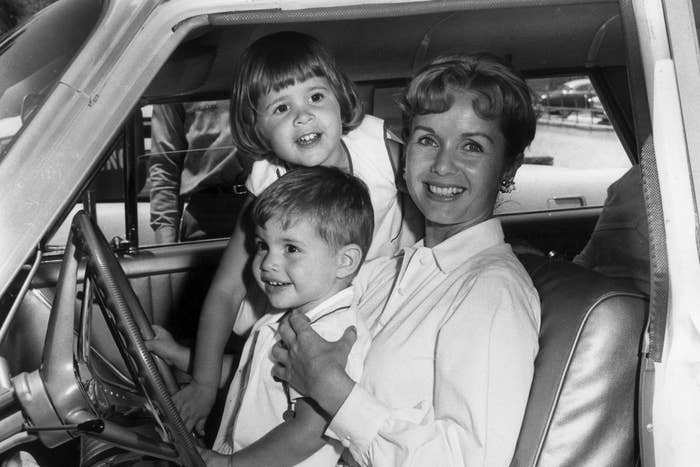
In the wake of Roe v. Wade’s overturn, a resurfaced clip of a 1989 interview with late actor Debbie Reynolds, the mother of star Carrie Fisher, is shedding light on how the decision will have an impact on one of the most heartbreaking of all experiences — a stillbirth, which is the death of a fetus at 20 weeks’ gestation or later.
Reynolds, famous for her roles in Singin’ in the Rain, The Unsinkable Molly Brown, and more recently Halloweentown, explained to comedian Joan Rivers that in 1962 she was forced to carry a dead fetus for about six weeks. She was seven-and-a-half months pregnant when she learned the fetus had died inside her; the laws at the time did not allow her to have an abortion to remove the fetus.
(Reynolds died in 2016 at age 84, one day after her daughter Fisher’s death.)
“It was a very hard thing to get over because in those days, there were no abortions allowed whether you were ill or whether you were raped or whether the child died, which is disgusting to think that there were those laws,” said Reynolds, who, because of the denial of care in the pre–Roe v. Wade era, almost died due to the stillbirth. “I had to carry the child full term. That was the law. It didn’t matter. It had to abort itself — it could not be taken from me.”
Women with a stillbirth are 14 times as likely to develop sepsis, 13 times as likely to experience kidney failure, and 10 times as likely to have a heart attack or other cardiac complication as people who have a live birth, according to one study by Stanford researchers.
Meanwhile, people who didn’t know about Reynolds’ stillbirth continued to ask her what she planned on naming the baby. “It’s just something that I never have forgotten — the pain of it,” Reynolds said at the time. “A lot of women go through this sort of thing.”
About 1 in 160 pregnancies result in a stillbirth, which can be caused by an infection, fetal impairment, drug or alcohol use, or for no obvious reasons at all.
After she eventually had an abortion to save her life, some months later she became pregnant again. The same thing happened around the same time of gestation. “The second baby died, just like that again, for no reason at all,” she said. This time, however, the doctors allowed her to abort the fetus because she had almost died during her previous stillbirth experience. “A seven-and-a-half-month-old baby,” Reynolds said. “It’s not an easy thing to do.”

Now, 60 years later, people across TikTok, Twitter, and other social media platforms are sharing her interview and reflecting on the similar, deadly challenges pregnant people today might face in the event they need or want an abortion — particularly those that occur later in pregnancy.
“Continuing a pregnancy to birth is always more risky and carries greater physical health risks than an abortion at any gestation,” said Katrina Kimport, a medical sociologist at the University of California, San Francisco, who studies the experiences of those seeking third-trimester abortions. “This is a uniquely difficult situation made worse by our public discourses’ inability to talk about abortion in a nonjudgmental, compassionate way.”
Abortions later in pregnancy are rare
Even during the roughly 50-year period when Roe was the law of the land, people who needed later abortions had to jump through extraordinary hoops to access care. Many states already restricted third-trimester abortions, which are heavily stigmatized and buried deep in misconceptions, including that they occur “moments before birth” or for reasons other than typically tragic circumstances.
In fact, there are only three clinics that offer third-trimester abortions in the US: Boulder Abortion Clinic in Colorado, Southwestern Women’s Options in New Mexico, and DuPont Clinic in Washington, DC, according to Erika Christensen, a later abortion patient advocate with Who Not When, a people-centered resource for understanding abortions later in pregnancy. Another clinic called Abortion Care will open in Maryland this fall.
Abortions that occur at or after 21 weeks of pregnancy (about halfway through the second trimester) represent less than 1% of all those performed in the US, according to CDC data from 2019.
The majority, about 93%, of abortions occur at or before 13 weeks or during the first trimester, while almost all of the remaining occur between 14 and 20 weeks.
There are many reasons people seek abortions after the first trimester
Contrary to popular belief, the small subset of people who seek abortions after the first trimester of pregnancy don’t “wait” to get one. Instead, the delays are usually due to new information and barriers to care.
The first “pathway” to later care, as Kimport calls it in her research, involves learning new details about a pregnancy during the second or third trimester that couldn’t have been learned earlier on, such as impaired brain development in the fetus. Other details about the fetus may emerge later in pregnancy because a person couldn’t afford to pay for certain diagnostic scans or appointments throughout their prenatal care, Kimport added.
Sometimes the pregnant person develops health issues late in their pregnancy that could kill them or the fetus (or both) if they don’t abort, including conditions like preeclampsia, newly diagnosed cancer, or an intrauterine infection (when membranes surrounding the fetus in the womb are infected). The further along a pregnancy someone goes, the greater the health risks.
During her third trimester in 2016, Christensen said her pregnancy became complicated, but she didn’t have access to the information she needed to make a decision until she was 30 weeks along.
“My doctors realized that my pregnancy was far more dangerous and doomed than they originally assessed,” Christensen told us. “By that time, I was already over the invisible line that I didn't know existed.” She had to travel from New York to Colorado to receive an abortion because New York at the time banned the procedure after 24 weeks. (As of 2019, the state permits abortions after 24 weeks if the fetus isn’t viable or the pregnant person’s health is in danger.)
New information could also include pregnancy itself. The average time people become aware of their pregnancy is around five and a half weeks, or about a week and a half after a missed period, with Black and Hispanic people more likely to find out later, research has found. Meanwhile, the majority of those who seek abortions after 20 weeks discover they are pregnant after eight weeks.
It really can happen to anyone, experts say, due in part to the unpredictable and erratic nature of menstruation. People who take birth control, have irregular periods (this includes many young people or those with certain conditions, such as PCOS), have obesity, are recently postpartum, or are taking certain medications that can cause symptoms similar to those of pregnancy, are among those who might not realize right away that they are pregnant.
I wanted my baby. My husband and I have tried for years. I got pregnant in august 2021 and then miscarried. My body doesn’t naturally expel so I needed a D&C. I was denied one because my doctor was worried about the laws here in Texas. I waited for 2 WEEKS carrying my loss while
It happened to Christensen, who, after one miscarriage and a subsequent late abortion at eight months, didn’t learn she was pregnant a third time until 16 weeks during an unrelated doctor’s appointment because her “body was so out of whack.”
“When you don't find out you're pregnant until the second trimester, many paths to care have already been cut off to you the day that you found out you're pregnant,” Christensen said. Later discoveries of pregnancy can also lead to delays in stopping drug or alcohol use that may harm the fetus or seeking prenatal care. “It just makes the whole ordeal really punishing and cruel to then make people jump through these extra hoops.”
There are other barriers to abortion, too, that existed even during Roe v. Wade, like cost, travel difficulties, childcare, lack of information about where to access care, and, of course, restrictive laws.
“Bans equal delays, which equal people seeking care later on. It’s actually a pretty simple line to draw; you've just automatically kicked the can down the road into pregnancy, so the need is just going to go up,” Christensen said.
The average cost of a second- or third-trimester abortion is $2,000, according to a 2013 study published in the journal Perspectives on Sexual and Reproductive Health, but it can reach $10,000 or more. Not to mention, most abortion seekers live below the federal poverty level.
The few studies on later abortions have found that people of color, younger people, those with lower incomes, and people with less education are more likely to seek abortions later in pregnancy.
Medicaid — the government-sponsored health insurance program for patients with low incomes — covers abortion care in only 16 states, according to the group Physicians for Reproductive Health. Coverage is so limited because of the Hyde Amendment, passed shortly after Roe v. Wade, which blocks the use of federal funds for abortion coverage (with exceptions for rape, incest, or life endangerment).
The same 2013 study found that women seeking abortions later in pregnancy were two times more likely than those seeking first-trimester abortions to face delays in care because of “difficulties securing public or private insurance coverage.”
Clinics that offer abortion care are also distributed unevenly across the US, and varying state gestational bans limit what kind of care people can receive and when.
The need for later abortion care will rise now that Roe has fallen, experts said, pushing people later into pregnancy when costs are higher and the number of providers willing or allowed to perform the procedure is lower. It's an effect that will be felt in neighboring states with fewer restrictions, too, as people are forced to travel and wait even longer for care.
What’s the future of abortions for pregnancies that threaten a person’s life?
Of course, people do not need a reason for an abortion other than they do not want to be pregnant.
However, many people assume that pregnant people whose life is at stake at any stage of gestation will still be allowed to have an abortion, even after Roe’s overturn; that’s not the case.
“This legislation (happening right now) will and is delaying care for ectopic pregnancies and patients with cancer who cannot receive chemo,” Dr. Deepjot Singh, an OB-GYN in Southern California, told us in an email. “The additional hoops, documentations, consultations with ethics committees, and legal is delaying lifesaving treatment to patients.”
“The distance between what people believe the law does and who it protects and what actually happens is pretty big,” Kimport said. “A lot of people are comfortable with restrictions on abortion later in pregnancy because they assume that in these admittedly rare situations, the people affected would fall into the exceptions.”
But the reality is that a lot of people are left out of them, she said.
The overruling of Roe v. Wade, as detrimental as it, does offer an opportunity to change the thresholds for abortion care in a way we’ve never been able to do before, Kimport said.
For example, using fetal viability as a legal standard for abortion bans is vague, loosely defined as when a fetus can survive outside the womb. Nineteen states impose abortion bans “at viability,” which is generally reached between 24 and 28 weeks since a person’s last menstrual period, according to the Guttmacher Institute, a sexual health and reproductive rights research and advocacy group.
Fetal viability is no more than an estimate based on several factors that differ per fetus, such as sex and weight, and depends on other external factors, such as the level of NICU care available at someone’s nearest hospital.
“What do we want the next round of policies and laws to look like? What are we going to demand for ourselves? Looking forward, what do we want now in modern times?” Christensen said. “I hope it’s full access to all reproductive health options without caveats, without limits, without restrictions.”
There’s a lot at stake right now, and we’ll learn more about the future of abortion care over time, but we can start changing how we talk about the procedure to ensure accurate information is shared, Kimport said.
“Instead of trying to justify individuals’ decisions and inviting others to decide if it’s OK,” she said, we need to center these conversations on the people who seek and have them, and the circumstances that put them in that position.

